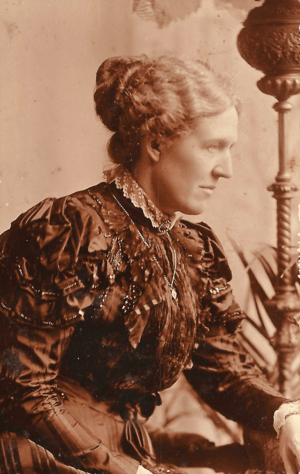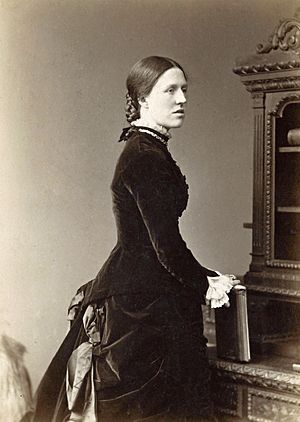Kathleen Lyttelton facts for kids
Quick facts for kids
Kathleen Lyttelton
|
|
|---|---|

Lyttelton in about 1898.
|
|
| Born |
Mary Kathleen Clive
27 February 1856 Belgravia, London, England
|
| Died | 12 January 1907 (aged 50) Perrystone Court, Herefordshire, England
|
| Nationality | British |
| Occupation | Women's activist, editor and writer |
| Spouse(s) |
Arthur Lyttelton
(m. 1880) |
| Children | 3 |
| Parent(s) |
|
Mary Kathleen Lyttelton (born Clive; 27 February 1856 – 12 January 1907) was a British activist, editor, and writer. She spent much of her life working to get women the right to vote. She also worked to improve women's lives in general.
After living in Cambridge for 11 years, she focused on her writing. She also worked with many women's groups. In her 1901 book Women and Their Work, she wrote that education for women was "essential to their true progress". She believed that having the right to vote was a key part of this education.
Contents
Early Life and Family
Mary Kathleen Clive was born on 27 February 1856 in Belgravia, London. Her father, George Clive, was a judge and a politician. Her mother was Ann Sybella Martha Farquhar.
In 1880, she married the Hon Arthur Lyttelton. He was a teacher at Keble College, Oxford. Her father was not sure about the marriage at first. But the marriage was strong, and they had three children: Margaret Lucy (born 1882), Archer Geoffrey (born 1884), and Stephen Clive (born 1887).
Life in Cambridge
In 1882, Kathleen and Arthur moved to the new Selwyn College, Cambridge. Arthur was chosen to be the first head of the college. When they moved in, the college was still being built. Only the front part was finished. They lived in some student rooms until the head's house was ready.
In 1884, Kathleen started The Cambridge Association For Women's Suffrage (CAWS). She started it with Millicent Fawcett. Fawcett encouraged her to join the main group for women's right to vote. Kathleen also helped the Cambridge Women's Refuge. This group helped raise money for poor local girls. It taught them practical skills for home and reading.
In 1890, Kathleen and her friend Louise Creighton started the Cambridge Ladies Dining Society. This group believed in women's education. They actively worked for the university to give degrees to women. Most members also strongly supported women getting the right to vote. Famous members included Caroline Jebb, Eleanor Sidgwick, and Mary Paley Marshall.
During their time at Selwyn, the Lytteltons also helped the College Music Society. They also supported the Boat Club, and Kathleen chose its colors.
Moving to Lancashire
The family left Cambridge in 1893 after 11 years. Arthur became the vicar (a type of priest) of Eccles Parish Church in Lancashire. In 1895, Kathleen and Arthur started the Manchester and Salford Women's Trade Union Council. Kathleen later became the head of its committee. This group aimed to check working conditions. It also helped low-paid workers join unions. Christabel Pankhurst and CP Scott were members of this council.
She also started the Eccles branch of the Co-operative Women's Guild. She became a vice president of the National Union of Women Workers. She also joined the Manchester National Society for Women's Suffrage. As a Poor Law Guardian (someone who helped the poor), she complained that officials in Manchester "ignored the air pollution."
In 1896, Kathleen's lectures were published as a book. It was called Common Sense For Housewives: Girls’ Life after Leaving School.
Life in Hampshire
In 1898, Arthur became a Suffragan Bishop (a type of church leader) of Southampton. The family then moved back south to Petersfield, Hampshire.
Kathleen was chosen as president of the National Union of Women's Workers in 1900 and again in 1901.
Her book Women and Their Work was published in 1901. It showed her strong religious beliefs. In the book, she stressed how important education was for women. She also wrote about the need for strong beliefs. She said that working-class women would naturally form strong opinions because of their hard lives. But middle and upper-class women, with easier lives, might not. She wrote that "not having the right to vote harms women's proper growth." She believed that "the education given by the vote is essential to their true progress." She thought that "the confusion will pass as years go on." She also believed that "the huge task will awaken women who don't care yet."
After Arthur died in February 1903, Kathleen edited his essays. This collection was called Modern Poets of Faith, Doubt and Paganism (1904).
Time in London
In June 1903, she became the editor of the women's section of The Guardian. This was a weekly church newspaper. In this role, she was the first to review and publish early writings by Virginia Stephen. Virginia Stephen later became the famous writer Virginia Woolf. Virginia was thankful at first. But by late 1905, she felt confident enough to complain. She said that Mrs. Lyttelton "sometimes changed her writing" and "improved the moral tone."
Kathleen moved to a house in Gower Street, London. It was near Millicent Fawcett's house. In 1906, they published a book together called Why Women Want the Vote.
Death
Kathleen died at age 50 on 12 January 1907. She passed away at her family's home, Perrystone Court, in Herefordshire. Her obituary (a notice of her death) in The Times newspaper did not mention her work for women's right to vote or for trade unions. It focused on her as a scholar and a "diligent critic." Other obituaries appeared in The Englishwoman's Review and The Guardian.


